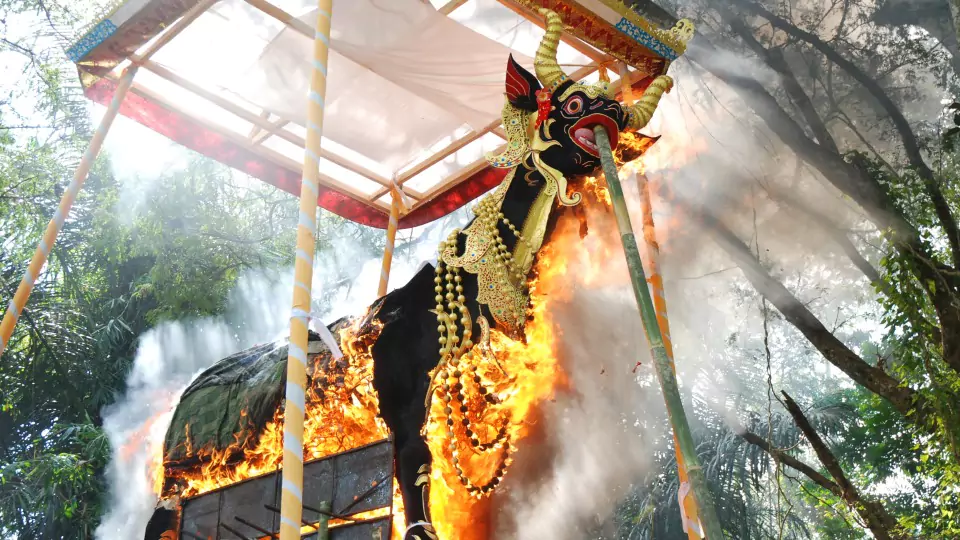Discover the captivating world of Balinese Hindu cremation ceremonies. Ancient rituals guide souls through a profound symbolic journey in this fascinating tradition. Deeply rooted in Balinese culture, it honors the deceased and holds deep spiritual meaning. Join us as we explore the four stages of a Balinese Hindu cremation ceremony. We’ll uncover the significance behind each step.
Stage 1: Memukur – Purifying the Body for the Balinese Hindu Cremation Ceremony

The Balinese Hindu cremation ceremony begins with the Memukur stage. Family members gather to cleanse and purify the deceased’s body with holy water. They dress it in special clothing and place it in a coffin. This process helps the soul release earthly attachments. It prepares the soul for the spiritual journey ahead.
Next, they move the body to a special pavilion called a “bale delod.” Loved ones pay their respects and offer prayers. This emphasises community support during the grieving process.
Stage 2: Ngaben – The Cremation Ceremony in Balinese Hindu Tradition

Ngaben, the main event of the ceremony, is when the actual cremation occurs. A lively procession, featuring offerings and traditional Balinese music, accompanies the coffin. They take it to the cremation ground. They place the coffin inside a unique structure called a “wadah.” This often resembles a temple or an animal, which they then set ablaze.
The fire symbolizes transformation. It releases the soul from the physical body. This enables its progression to the next stage of the journey.

Stage 3: Nganyut – Releasing the Ashes in the Balinese Cremation Ritual

After the cremation, family members collect the ashes. They bring them to a holy river or the sea for the Nganyut stage. This step symbolizes the return of the body’s physical elements to nature. They place the ashes in a coconut shell. Then, they release them into the water along with offerings like flowers and incense.
This ritual helps the soul find its way to the afterlife. It also ensures a respectful return of the physical remains to the earth. This highlights the interconnectedness of life and the natural world.
Stage 4: Mukur – Guiding the Soul in Balinese Hindu Funeral Rites

The final stage, Mukur, focuses on guiding the soul to the Upper World. A Balinese Hindu priest or “pemangku” performs rituals and offerings. This assists the soul’s navigation through the afterlife. It ensures the soul’s safe arrival at the final destination.
During Mukur, the priest performs the crucial “penyekeb” ritual. Using specific hand gestures, the priest symbolically closes the deceased’s eyes, ears, and mouth. This action helps the soul detach from the physical world. It allows the soul to focus on its spiritual journey.
Conclusion:
The Balinese Hindu cremation ceremony is a beautiful, meaningful tradition. It honors the deceased while guiding their soul through a symbolic journey to the afterlife. Each stage holds deep spiritual significance. It reminds us of the interconnectedness of life, death, and nature. By understanding and appreciating these rituals, we gain greater respect. We appreciate the diverse beliefs and traditions that shape our world.
Frequently Asked Questions (FAQ):
- Q: How long does a Balinese Hindu cremation ceremony usually last?
A: The duration of a Balinese Hindu cremation ceremony varies based on the region and the deceased’s status, but it typically spans several days. The Memukur stage can last a few days, while the Ngaben cremation ceremony itself usually takes place on a single day. - Q: What happens if a family cannot afford a Balinese Hindu cremation ceremony?
A: In Balinese Hindu tradition, cremation is considered essential for the soul’s journey to the afterlife. If a family cannot afford the ceremony, the community often comes together to help with expenses. In some cases, a simpler cremation may be performed, or the body may be temporarily buried until the family can afford the proper Balinese Hindu funeral ceremony. - Q: Are there any specific rules for visitors attending a Balinese Hindu cremation ceremony?
A: Visitors should dress respectfully, covering their shoulders and knees. It’s important to follow the local community’s guidance and be mindful of specific customs. Taking photos or videos of the Balinese cremation ritual is generally discouraged, as it is considered a sacred and private event. - Q: What is the significance of the animal-shaped structures in the Balinese Hindu cremation ceremony?
A: The animal-shaped structures, called “wadah,” are chosen based on the region and the deceased’s status. Each animal holds symbolic meaning; for example, a cow represents prosperity, while a lion represents strength and courage. These structures are believed to help guide the soul on its journey to the afterlife during the Balinese Hindu funeral rites. - Q: What do Balinese Hindus believe happens to the soul after the cremation ceremony?
A: In Balinese Hindu belief, the soul undergoes a process of reincarnation. The Balinese Hindu cremation ceremony helps the soul let go of its attachments to the physical world and move on to the next stage of its spiritual journey. The soul’s final destination is believed to be determined by the actions and karma accumulated during its earthly life.
For more information on Balinese Hindu traditions and ceremonies, visit our Blog page.

